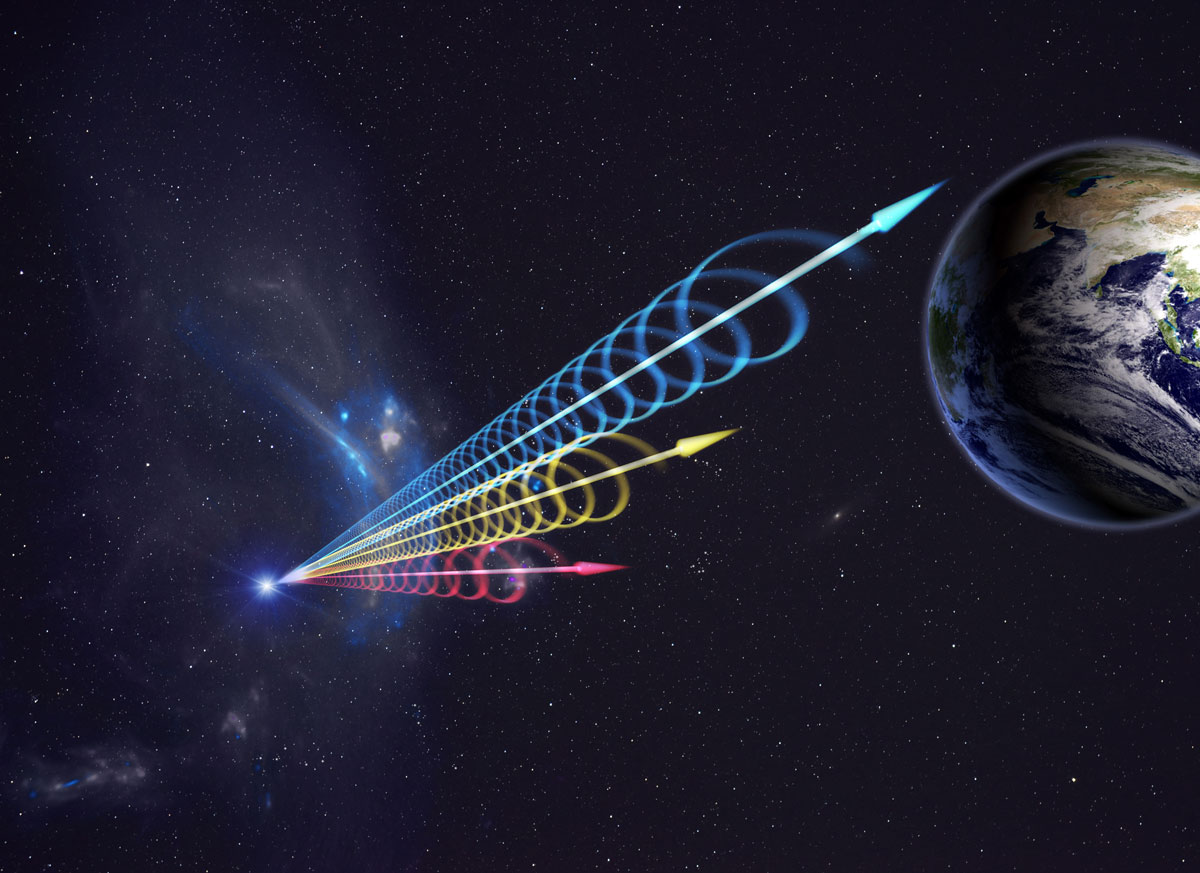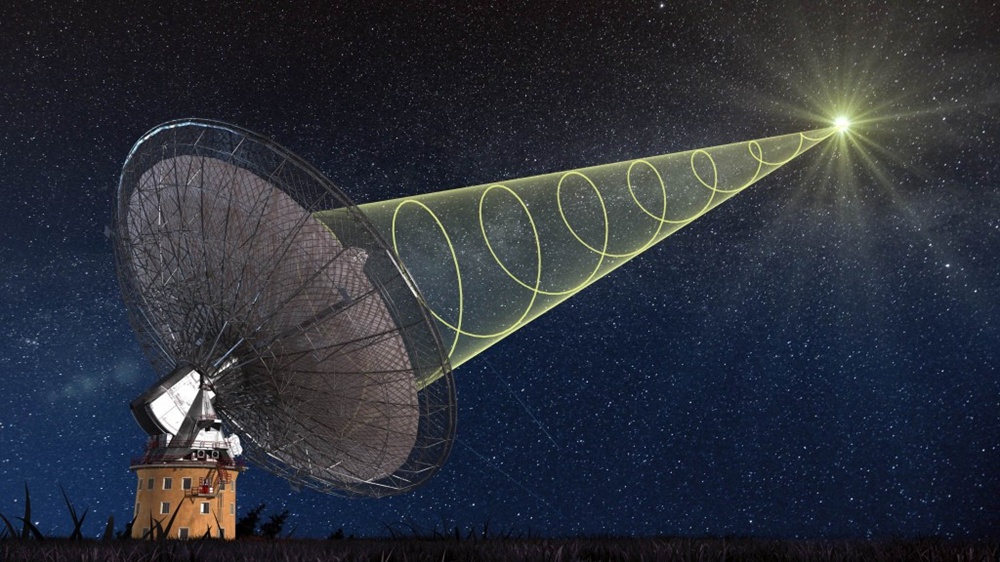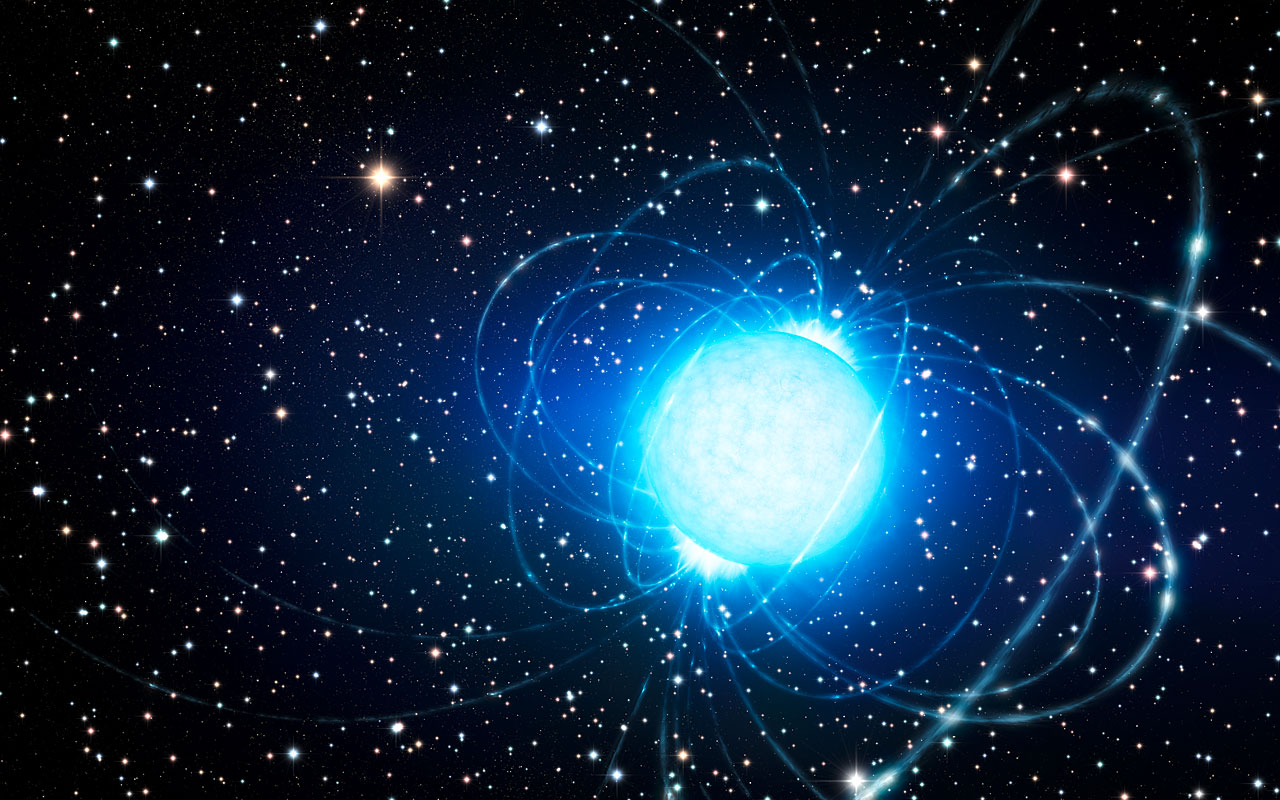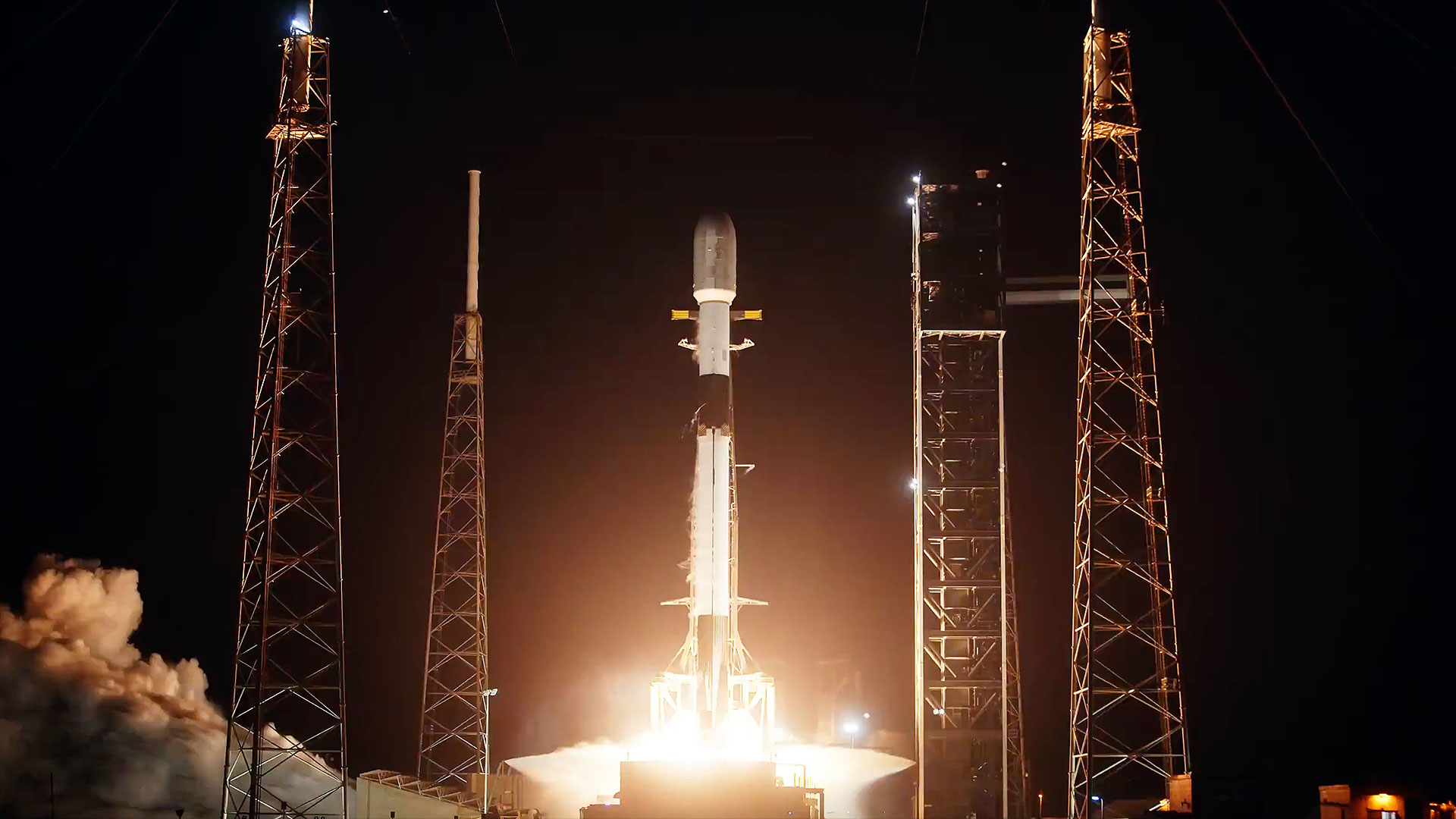What are fast radio bursts?
Fast radio bursts — fleeting blasts of energy that are brighter than entire galaxies — remain mysterious. Here's what we know (and don't know) about FRBs.
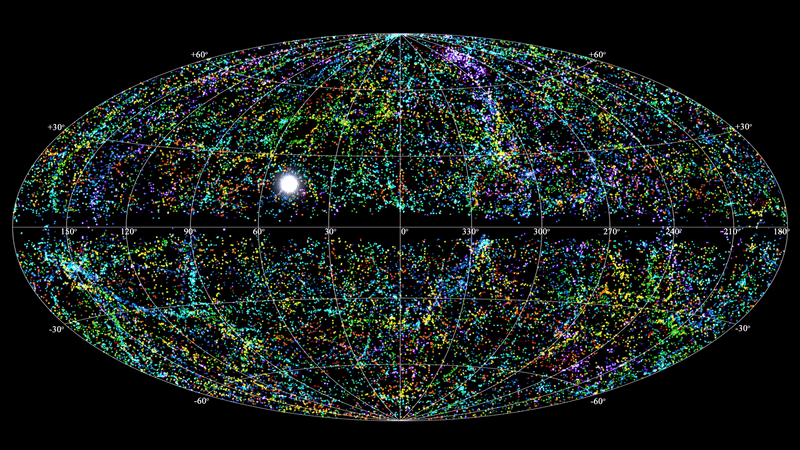
Fast radio bursts — fleeting blasts of energy that are brighter than entire galaxies — remain mysterious. Here's what we know — and don't know — about FRBs.
Fast radio bursts (FRBs) are intense blasts of radio waves that can emit as much energy as the sun puts out in three days — but in just thousandths of a second. Much about these events remains mysterious.
FRBs come from all over the sky and have frequencies of around 1,400 hertz, though some have been detected with frequencies as low as 400 to 800 hertz. Some scientists estimate that 10,000 FRBs could occur at random points in the sky over Earth each day. However, most FRBs last just milliseconds, and by the time their energy has reached Earth, it is 1,000 times weaker than a mobile phone signal would be if it were emitted from the moon and detected on Earth. Because these signals are so weak and so brief, FRBs are incredibly difficult to spot.
Related: What are cosmic rays?
As such, much about FRBs remains unknown. Scientists don't know exactly what causes FRBs. Proposed candidates include magnetars, rapidly rotating neutron stars with powerful magnetic fields; merging faint, dense stellar remnants called white dwarfs; collapsing neutron stars, or "blitzars"; and colliding galaxies.
Some things are certain about FRBs, however. For one, their sources must be highly energetic themselves, and as they travel, these short-lived radio-wave blasts can gather information about cosmic environments, like the clouds of interstellar gas they pass through. That makes studying FRBs a pressing concern for astronomers who want to map the universe.
Fast radio burst FAQs
What are fast radio burst signals?
A fast radio burst is a bright and brief burst of electromagnetic radiation (light) seen in radio-wave frequencies. They usually last thousandths of a second. Some FRBs repeat, but the vast majority happen once and disappear forever.
What causes fast radio bursts?
Scientists don't know for sure what causes fast radio bursts, but they have proposed a number of possible suspects, including highly magnetic neutron stars called magnetars, colliding neutron star binaries, and merging white dwarfs.
How powerful are fast radio bursts?
At their sources, fast radio bursts have a lot of energy: In a millisecond, some FRBs can blast out as much energy as the sun emits in three Earth days. Because they come from billions of light-years away, however, FRBs lose energy as they travel, so when they reach Earth, they are much less powerful. When radio telescopes spot FRBs from Earth, the strength of the signal is similar to a mobile phone signal from the moon.
Fast radio burst discoveries
The Parkes Observatory in Australia made the first detection of an FRB as it blasted out of the Small Magellanic Cloud, a satellite galaxy of the Milky Way, in 2001. However, this event would not be discovered until 2007, when astrophysicist Duncan Lorimer and colleagues found it in archival data from the observatory.
Breaking space news, the latest updates on rocket launches, skywatching events and more!
Lorimer and crew described the FRB as a "bright millisecond radio burst of extragalactic origin" in a paper the same year. The first recognized FRB would later become known as the "Lorimer burst" in his honor, but it was officially designated FRB 010724. The Lorimer burst, which lasted around 5 milliseconds and did not repeat, remains one of the brightest FRBs detected to date — something that has been solidified by further investigations.
The second FRB to be detected — the Keane burst, or FRB 010621 — was observed in data from the Parkes Multibeam Pulsar Survey in 2011.
In 2012, the Arecibo Observatory, a former radio telescope in Puerto Rico, discovered the first repeating FRB, designated FRB 121102. This discovery confirmed that, in at least some instances, the source of these powerful blasts of radiation survived that emission. This ruled out many cataclysmic models for FRBs, or at least for the rare repeating FRBs.
The discovery of FRB 121102, which seems to have emerged from a galaxy 3 billion light-years away, was also significant because it marked the first time a telescope other than the Parkes Observatory had spotted an FRB. This helped to confirm that these events weren't the result of some environmental quirk unique to the Australian observatory.
The next year, the term "fast radio burst" was coined to describe this type of event, according to the California Institute of Technology.
Although these FRBs were the first to be detected, they are by no means the earliest FRBs to have occurred. In June 2022, astronomers using the Australian Square Kilometre Array Pathfinder, a radio interferometer consisting of 36 12-meter (39 feet) antenna dishes, spotted an FRB that originated from 13 billion light-years away. This made the burst, designated FRB 20220610A, the most distant — and thus the earliest — FRB ever seen, potentially launched when the universe was less than 1 billion years old.
Not all FRBs are so distant, however. The FRBs described above — and the vast majority of FRBs discovered to date — originate from galaxies outside the Milky Way. So another significant discovery was finding such an explosive event that emerged within our own galaxy.
The burst, designated FRB 200428, was spotted in April 2020 by the Canadian Hydrogen Intensity Mapping Experiment (CHIME) and the Survey for Transient Astronomical Radio Emission 2 (STARE2), an array of three radio antennas in California and Utah. It lasted just 1.5 milliseconds and emerged from only 30,000 light-years away, toward the heart of our galaxy.
The longest FRB ever seen was FRB 20191221A, which was first spotted in 2019 by scientists using CHIME. This FRB lasted three seconds, making it around 1,000 times longer than the average FRB. It also had periodic peaks, with its discoverers comparing it to a cosmic "heartbeat."
Do fast radio bursts repeat?
There is a clear distinction between repeating and non-repeating FRBs.
Since their discovery, over 1,000 FRBs have been observed. Until 2017, 10 years after the discovery of the Lorimer burst, only 140 FRBs had been discovered, according to McGill University. This changed thanks to CHIME, which in 2021 alone discovered an incredible 535 FRBs.
The vast majority of FRBs discovered to date are non-repeating. For instance, in that cluster of 535 CHIME-detected FRBs, only 18 were repeating. In April 2023, using CHIME, astronomers doubled the number of known repeating FRBs from 25 to 50.
The dearth of repeating FRBs, in addition to their incredibly brief nature, has kept the origins of these bursts shrouded in mystery, as astronomers can't use a second instance to better ascertain where the FRBs are coming from.
Some researchers have suggested that the FRB catalog may lack repeating FRBs simply because we have not studied the sky long enough to detect many repeat occurrences. Yet repeating FRBs seem to differ from their non-repeating counterparts in certain ways. For example, repeating FRBs seem to last longer but manifest over a tighter range of radio-wave frequencies than non-repeating FRBs do, which suggests that repeating and non-repeating FRBs come from different sources, according to McGill University.
What causes fast radio bursts?
Astronomers aren't entirely sure what causes fast radio bursts, but there are some hints as to their sources. Because FRBs last just milliseconds, they likely originate from very compact objects; light would have to traverse the object in the same period it takes an FRB to peak and then disappear. The energy of FRBs suggests that they may sit in violent and energetic environments.
These clues have led scientists to propose compact stellar remnants, such as white dwarfs and neutron stars, as candidates for the source of FRBs. One main suspect for the source of FRBs is magnetars, rapidly spinning neutron stars that possess the most powerful magnetic fields in the known universe.
Like all neutron stars, magnetars are born when massive stars collapse at the end of their lives when the fuel for nuclear fusion has been exhausted. The outer layers of the star are shed leaving a stellar core with a mass around that of the sun. This collapses down to the width of a city here on Earth, leaving a stellar remnant with a diameter now wider than 12 to 20 miles–a neutron star.
But because angular momentum is conserved in physics, this rapid shrinking also causes neutron stars to "spin up" and rotate at speeds as great as 700 times per second. It also crams the magnetic field lines of that dying star closer together, and closer field lines mean a stronger magnetic field. All neutron stars are highly magnetic, but around 1% possess the most powerful magnetic fields in the known universe, and these are called magnetars. The magnetic fields of magnetars can be one thousand trillion times stronger than Earth's magnetosphere, according to NASA. These powerful magnetic fields could lead to outbursts from magnetars that, in turn, lead to FRBs.
Strong evidence for this model of origin came in 2020 when the Milky Way radio-wave blast FRB 200428 was traced to the magnetar SGR 1935+2154. The team behind this detective work also discovered that FRB 200428 corresponded with a burst of X-rays, suggesting that emission models favoring pulses of electromagnetic radiation caused by magnetar bursts and flares might be responsible for FRBs. Magnetars would survive this emission, which could explain why some FRBs are seen to repeat, the researchers said.
The collision and subsequent merger of neutron stars have also been suggested as a possible origin of FRBs. When the neutron stars slam into each other, this collision leaves behind a highly magnetized "supermassive compact object" that quickly collapses into a black hole, ejecting the magnetosphere of that supermassive black hole precursor object and thus causing the FRB.
This idea is supported by the 2022 detection of an FRB that appears to be associated with the emission of gravitational waves from a neutron star merger. This merger would be a one-time event and could account for non-repeating FRBs. However, it would not explain why some FRBs repeat.
According to The Planetary Society, another possible "collapse scenario" that has been suggested for the creation of FRBs relates to a "blitzar." This intense burst of radio waves is caused by the sudden collapse of a supermassive neutron star that should have immediately collapsed into a black hole but was instead protected by its own rapid rotation.
White dwarfs, which form when lower-mass stars like the sun run out of hydrogen for nuclear fusion, could create highly magnetized stars when they collide and merge. These collisions could also trigger cosmic explosions called Type Ia supernovas, which could be discovered if there is an association between these supernovas and FRBs. It is also possible that the collision of white dwarfs with neutron stars creates a magnetar, leading to FRBs.
One outside possibility suggests that FRBs don't actually emerge from sources outside the Milky Way and that the appearance of having traveled from extragalactic sources is created when these radio bursts travel through a thick medium of plasma around a star, according to The Planetary Society. This would mean that FRBs are the result of flaring stars in the Milky Way, which could be evidenced if FRBs were found to be associated with variable stars in our galaxy. But such a link has yet to manifest.
Fast radio burst expert Q&A
We spoke to Alex Moroianu, Curtin University Astrophysics Masters graduate about fast radio bursts.

Alex Moroianu is an astrophysics master's graduate from Curtin University. In March 2023 Moroianu helped to unravel some of the mystery surrounding fast radio bursts with a paper published in the Journal Nature.
How does your research connect to fast radio bursts?
Our research centers around testing the source origins of fast radio bursts. Right now, the leading source candidate is young, active magnetars (highly magnetised neutron stars).
Are there other possible fast radio burst sources?
The properties of fast radio bursts — namely, the differences between repeaters and non-repeaters ë imply that there may be multiple source origins. Compact object mergers (i.e mergers between black holes and/or neutron stars) have long been theorised to be potential FRB sources.
How could the connection between merging black holes and fast radio bursts be proved?
Our research searches for coincidences between gravitational waves emitted by such compact object mergers and fast radio bursts to investigate if they're related. It's important to caveat, however, that if they are found to be related, compact object mergers can only explain around 1% of FRBs. That is very bright non-repeaters. So we still need to invoke active magnetars and other potential source origins to explain the other 99% or so.
Why are fast radio bursts considered mysterious?
Fast radio bursts are mysterious because, even though we've detected hundreds in the past couple of decades, we're still not fully sure where they come from!
Additional resources
Fast radio bursts aren't the only powerful and mysterious energy blasts that puzzle astronomers. Gamma-ray bursts, first discovered in the 1960s, are some of the most powerful emissions in the universe. You can learn more about them on NASA's Hubblesite. The first FRB emerged from the Small Magellanic Cloud. Learn more about this Milky Way satellite galaxy and see some stunning images of it captured by the Herschel Space Observatory. At least one known fast radio burst comes from a source that isn’t extragalactic. You can read more about the observation of FRBs from a magnetar within the Milky Way in this paper.
Bibliography
Fast Radio Bursts, Cosmos Swinburne Center for Astrophysics and Supercomputing, Accessed 08/10/23, [https://astronomy.swin.edu.au/cosmos/F/Fast+Radio+Bursts]
The Lorimer Burst, The Planetary Society, Accessed 08/10/23, [https://www.planetary.org/space-images/the-lorimer-burst]
FRB FAQ, UTMOST, Accessed 08/10/23, [https://astronomy.swin.edu.au/research/utmost/?page_id=1725#:~:text=How%20often%20do%20FRBs%20occur,our%20most%20sensitive%20radio%20telescopes.]
Upgraded UTMOST finds its first Fast Radio Burst, UTMOST, Accessed 08/10/23, [https://astronomy.swin.edu.au/research/utmost/?p=2829]
A.G. Mannings., et al, Fast Radio Bursts as Probes of Magnetic Fields in Galaxies at z < 0.5, [2022], [https://arxiv.org/abs/2209.15113]
D. R. Lorimer., et al, A Bright Millisecond Radio Burst of Extragalactic Origin, Science, [2007], [https://arxiv.org/abs/0709.4301]
Landmark FRB Discoveries, Caltech, Accessed 08/10/23, [http://ned.ipac.caltech.edu/level5/March19/Petroff/Petroff5.html]
Focus on the Repeating Fast Radio Burst FRB 121102, The Astrophysical Journal Letters, Accessed 08/10/23, [https://iopscience.iop.org/journal/2041-8205/page/Focus_on_FRB_121102]
Over 500 new FRBs detected in a single year due to CHIME telescope, McGill University, Accessed 08/10/23, [https://www.mcgill.ca/newsroom/channels/news/over-500-new-frbs-detected-single-year-due-chime-telescope-331426#:~:text=Among%20the%20535%20FRBs%20in,single%2C%20non%2Drepeating%20FRBs.]

Robert Lea is a science journalist in the U.K. whose articles have been published in Physics World, New Scientist, Astronomy Magazine, All About Space, Newsweek and ZME Science. He also writes about science communication for Elsevier and the European Journal of Physics. Rob holds a bachelor of science degree in physics and astronomy from the U.K.’s Open University. Follow him on Twitter @sciencef1rst.
